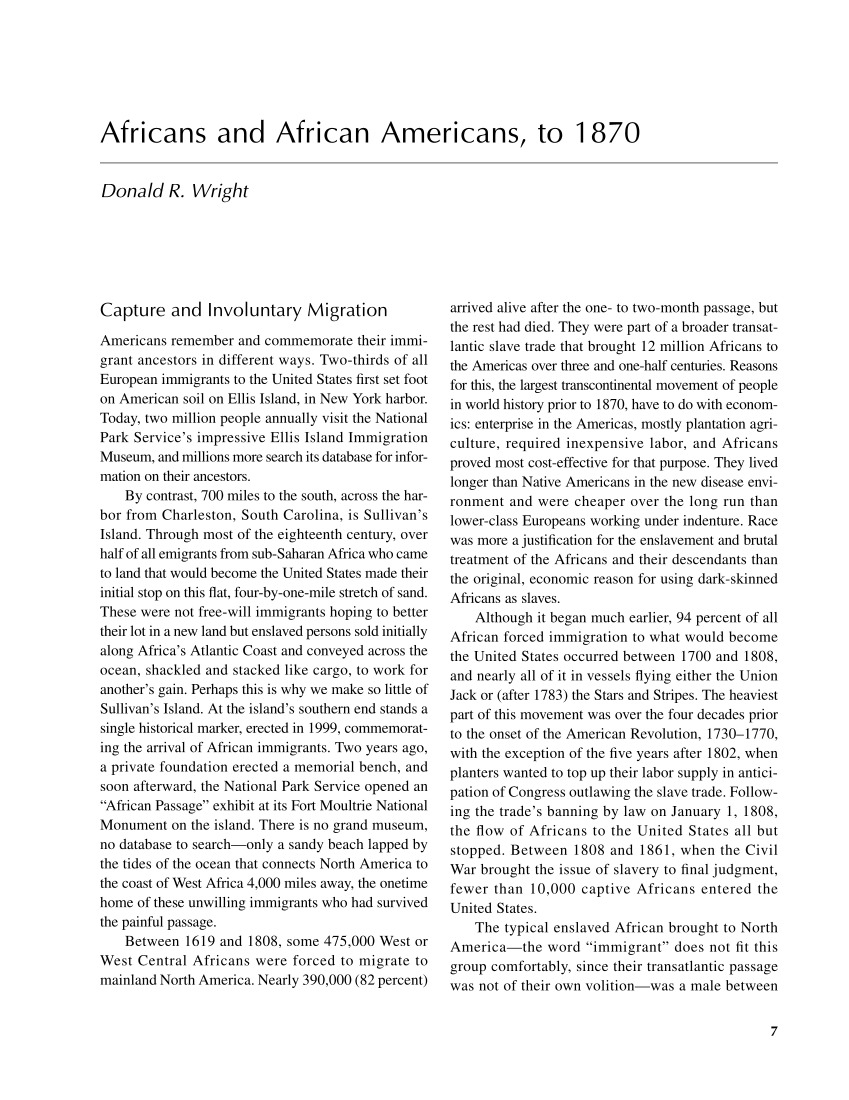Africans and African Americans, to 1870 Donald R. Wright Capture and Involuntary Migration Americans remember and commemorate their immi- grant ancestors in different ways. Two-thirds of all European immigrants to the United States first set foot on American soil on Ellis Island, in New York harbor. Today, two million people annually visit the National Park Service’s impressive Ellis Island Immigration Museum,andmillionsmoresearchitsdatabase forinfor- mation on their ancestors. By contrast, 700 miles to the south, across the har- bor from Charleston, South Carolina, is Sullivan’s Island. Through most of the eighteenth century, over half of all emigrants from sub-Saharan Africawho came to land that would become the United States made their initial stop on this flat, four-by-one-mile stretch of sand. These were not free-will immigrants hoping to better their lot in a new land but enslaved persons sold initially along Africa’s Atlantic Coast and conveyed across the ocean, shackled and stacked like cargo, to work for another’s gain. Perhaps this is why we make so little of Sullivan’s Island. At the island’s southern end stands a single historical marker, erected in 1999, commemorat- ing the arrival of African immigrants. Two years ago, a private foundation erected a memorial bench, and soon afterward, the National Park Service opened an “African Passage” exhibit at its Fort Moultrie National Monument on the island. There is no grand museum, no database to search—only a sandy beach lapped by the tides of the ocean that connects North America to the coast of West Africa 4,000 miles away, the onetime home of these unwilling immigrants who had survived the painful passage. Between 1619 and 1808, some 475,000 West or West Central Africans were forced to migrate to mainland North America. Nearly 390,000 (82 percent) arrived alive after the one- to two-month passage, but the rest had died. They were part of a broader transat- lantic slave trade that brought 12 million Africans to the Americas over three and one-half centuries. Reasons for this, the largest transcontinental movement of people in world history prior to 1870, have to do with econom- ics: enterprise in the Americas, mostly plantation agri- culture, required inexpensive labor, and Africans proved most cost-effective for that purpose. They lived longer than Native Americans in the new disease envi- ronment and were cheaper over the long run than lower-class Europeans working under indenture. Race was more a justification for the enslavement and brutal treatment of the Africans and their descendants than the original, economic reason for using dark-skinned Africans as slaves. Although it began much earlier, 94 percent of all African forced immigration to what would become the United States occurred between 1700 and 1808, and nearly all of it in vessels flying either the Union Jack or (after 1783) the Stars and Stripes. The heaviest part of this movement was over the four decades prior to the onset of the American Revolution, 1730–1770, with the exception of the five years after 1802, when planters wanted to top up their labor supply in antici- pation of Congress outlawing the slave trade. Follow- ing the trade’s banning by law on January 1, 1808, the flow of Africans to the United States all but stopped. Between 1808 and 1861, when the Civil War brought the issue of slavery to final judgment, fewer than 10,000 captive Africans entered the United States. The typical enslaved African brought to North America—the word “immigrant” does not fit this group comfortably, since their transatlantic passage was not of their own volition—was a male between 7
Document Details My Account Print multiple pages
Print
You have printed 0 times in the last 24 hours.
Your print count will reset on at .
You may print 0 more time(s) before then.
You may print a maximum of 0 pages at a time.









































































































































































































































































































































































































































































































































































































































































































































































































































































































































































































































































































































































































































































































































































































































































































































































































































































































































































































































































































































































































































































































































































































































































































